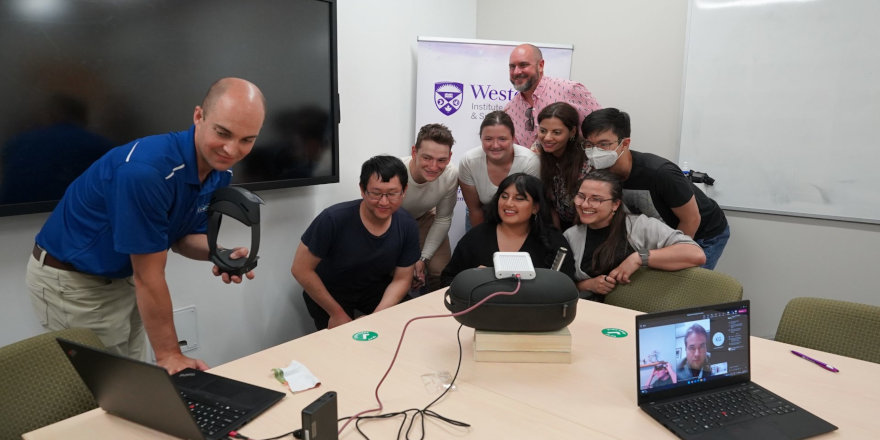Western University Team Achieves International Holographic Teleportation
Game-changing tech can have implications for health care, space work, and more. Plus, it's like sci fi come to life!

Article originally written by Justin Zadorsky; edited for length and clarity on reposting. Read the original article in its entirety here.
Holographic teleportation sounds like something out of science fiction, but instead of the bridge of an interstellar spaceship, this futuristic achievement recently took place in a boardroom at Western University.
The term holographic teleportation, or holoport, is a portmanteau of "hologram" and "teleport": when a hologram of a person or object is transmitted instantaneously to another location.
In July, a small group of students from the Western Institute for Space Exploration (Western Space) gathered to witness and take part the first international holoport demonstration: the first time anyone has crossed international borders through holographic teleportation.
"We transported one person from Alabama to London, Ontario, and then each of the students here on the project were able to instantly holoport themselves in holographic form down to Huntsville, Alabama," said Dr. Adam Sirek, a faculty member at the Schulich School of Medicine & Dentistry, and Western Space.
The team, comprised largely of undergraduate and medical students, is exploring the way this futuristic technology can be used in the real world. Whether it's for people communicating, or providing assistance and medical care to remote areas, the possibilities are just becoming apparent.
Precipice of opportunity
The technology for holographic teleportation involves a special camera that creates a holographic image of a subject, which is then sent to the destination. The user on the other end is wearing a device called a hololens — like a virtual reality gaming headset. Through the hololens, the individual can see the subject within their environment. If both users are wearing a hololens, they can interact in their environments as if they're actually there.
While the novelty of instant travel is fascinating, for medical student and project intern Adam Levschuk, the possibilities for medical care are most exciting.
"It's like the best of both worlds between medicine and engineering. The applications I'm particularly looking at is facilitating physical exams that a doctor would normally conduct in an examination room," he said. There's still work to be done to make hololens medical exams a reality, but students are excited to explore the possibilities.
Engineering healthcare applications
Medical student and project intern Alex Zhou said the implications of the technology could be huge for access to healthcare in remote locations. "This is very much the future of health care in terms of accessing remote communities, remote environments, and providing rural healthcare access," said Zhou.
Compared to the cost of medivacs, or even travelling for exams, this technology could mean huge cost savings for the healthcare system.
"As far as the hololens goes, I'm sort of looking at what biosensors might be really easy and also really helpful to integrate with it," said Jocelyn Whittal, a third-year engineering student. "Whether that's monitoring heart rate, oxygen saturation, or even looking at haptics."
(Haptics is the science and technology of transmitting and understanding info through touch — with holograms, this is a big hurdle!)
While the tech can transport a person's image across borders, it can't yet interact with touch, which is a big part of a medical exam.
Next steps for this ground-breaking tech
One of the most obtainable possibilities for the general public is its potential to connect people. Virtual meetings are the norm now, but with holoports, a physical, three-dimensional experience could become mainstream.
"Wouldn't it be nice if you're on a three-month deployment to the space station, and you could come down and sit at home for a family dinner," Sirek said.
He adds that one of the most exciting parts is seeing a new generation of students taking on the challenges of today for a better world tomorrow.
"We have three undergraduate students taking advanced technology and potentially demonstrating that to leaders and decisions-makers for the future of Canada. Our students are actively involved in pushing the boundary of what novel technology can do."
Check out the latest at Western Space